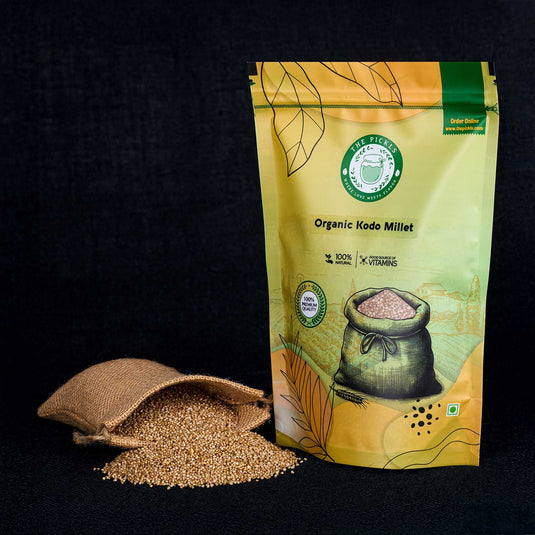Foxtail Millet: A Nutrient-Packed Superfood for Your Health
Foxtail millet, known by different names such as Korra (Telugu: కొర్ర), Navane (Kannada: ನವಣೆ), Tinai (Tamil: தினை), Kangni (Hindi: कांगनी), and Thina (Malayalam: തിനൈ), is an ancient grain that is making a significant comeback in health-conscious diets. This gluten-free, low-glycemic food is loaded with essential nutrients, making it an excellent choice for individuals looking to improve their overall health. Whether you’re enjoying foxtail millet in India or preparing it for its many millet benefits, this grain is a great addition to any meal plan.
What Makes Foxtail Millet So Nutritious?
One of the key reasons foxtail is considered a superfood is its exceptional nutrition profile. Packed with protein, fiber, and vital minerals like magnesium, iron, and potassium, it provides numerous health benefits. These nutrients are important for maintaining strong bones, supporting the immune system, and promoting heart health. Additionally, foxtailbenefits for weight loss come from its ability to promote satiety and curb overeating.
The Health Benefits of Foxtail Millet
Rich in Dietary Fiber
Foxtail is a fiber-rich grain that supports digestion and ensures regular bowel movements. This high-fiber content also helps regulate blood sugar levels and can lower cholesterol, reducing the risk of heart disease. Furthermore, it’s an excellent food for foxtail benefits for weight loss, as it promotes fullness and reduces cravings, making it easier to manage your weight.
Supports Heart Health
The antioxidants and magnesium found in foxtail help to reduce inflammation, improve circulation, and regulate blood pressure. As a result, it plays a role in maintaining cardiovascular health. Regular consumption of foxtail can be an excellent way to improve heart health, along with maintaining a balanced diet.
Helps with Blood Sugar Management
Thanks to its low glycemic index, foxtail millet benefits for diabetes are significant. Unlike refined carbohydrates that cause blood sugar spikes, this millet releases glucose slowly into the bloodstream, ensuring better blood sugar control. This feature makes foxtail an ideal choice for individuals looking to stabilize their blood sugar levels.
Improves Skin Health
Beyond its internal benefits, foxtail millet benefits for skin are also noteworthy. The antioxidants in this grain help to reduce oxidative stress, which is linked to aging and skin problems. By adding foxtail to your diet, you can enjoy clearer and more youthful-looking skin.
How to Include Foxtail Millet in Your Diet
Thanks to its versatility, foxtail millet (Korra, Navane, Tinai, Kangni, Thina) can be easily incorporated into a variety of dishes. Whether you're making a warm breakfast or a hearty lunch, here are some ideas to get started:
- Millet Porridge: A wholesome breakfast made by cooking foxtail millet in water or milk, then topping it with fruits and nuts for a delicious start to your day.
- Millet Upma: This savory dish combines foxtail with vegetables and spices, making it a nutritious and filling meal.
- Millet Dosa: A gluten-free alternative to traditional dosas, perfect for breakfast or dinner.
- Salads: Add cooked foxtail to salads for extra fiber and a protein boost.
- Rice Substitute: Replace rice with foxtail in curries or stews for a nutrient-dense alternative.
Foxtail Millet Recipes to Try
Foxtail Millet Porridge
- Cook foxtail millet in milk or water until soft.
- Add honey, cinnamon, and top with fresh fruits like bananas or berries.
-
This simple, fiber-packed porridge makes for a heart-healthy breakfast.
Savory Foxtail Millet Salad
- Combine cooked foxtail with chopped veggies like cucumbers, tomatoes, and bell peppers.
- Dress with olive oil, lemon juice, salt, and pepper.
-
Garnish with fresh herbs like cilantro for a refreshing, nutritious salad.
Foxtail Millet: Advantages and Disadvantages
While foxtail benefits are many, it’s important to recognize potential foxtail disadvantages. Some people may experience bloating or digestive discomfort if they consume too much fiber at once. However, when incorporated in moderation, it can be a highly beneficial food for most people. Additionally, foxtail may not be readily available in all regions, though it is widely consumed in various parts of India.
Advantages:
- High in fiber, which aids in digestion and promotes fullness.
- Supports heart health and weight loss.
-
A gluten-free grain, making it suitable for people with gluten sensitivity.
Disadvantages:
- May cause digestive discomfort if consumed in excess.
-
Availability might be limited in some areas.
Conclusion
Foxtail millet is not just another ancient grain—it’s a nutrient-packed, gluten-free superfood with numerous health benefits. From aiding in digestion to supporting heart health and promoting healthy skin, the foxtail millet benefits are vast. Whether you're making foxtail millet recipes like porridge, upma, or salads, or simply using it as a rice substitute, adding millet to your meals is a great way to support your overall health.









